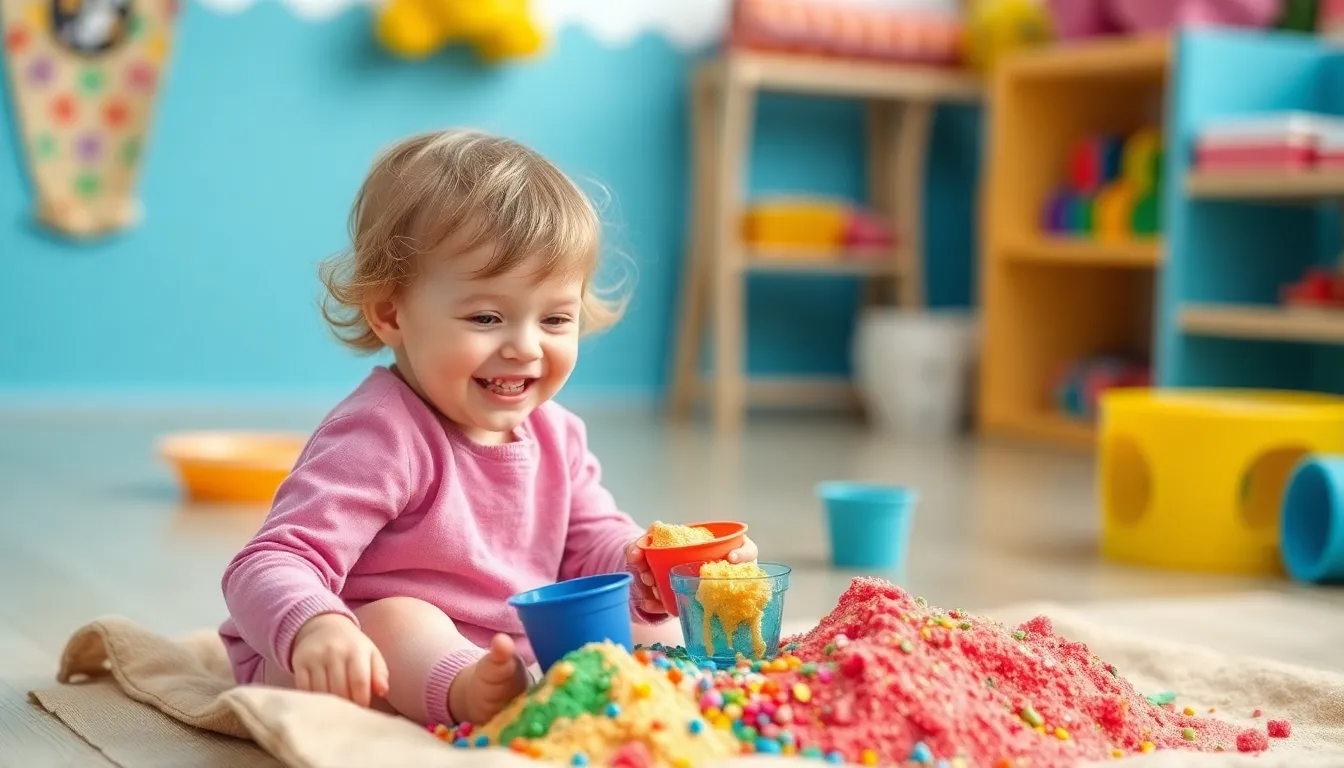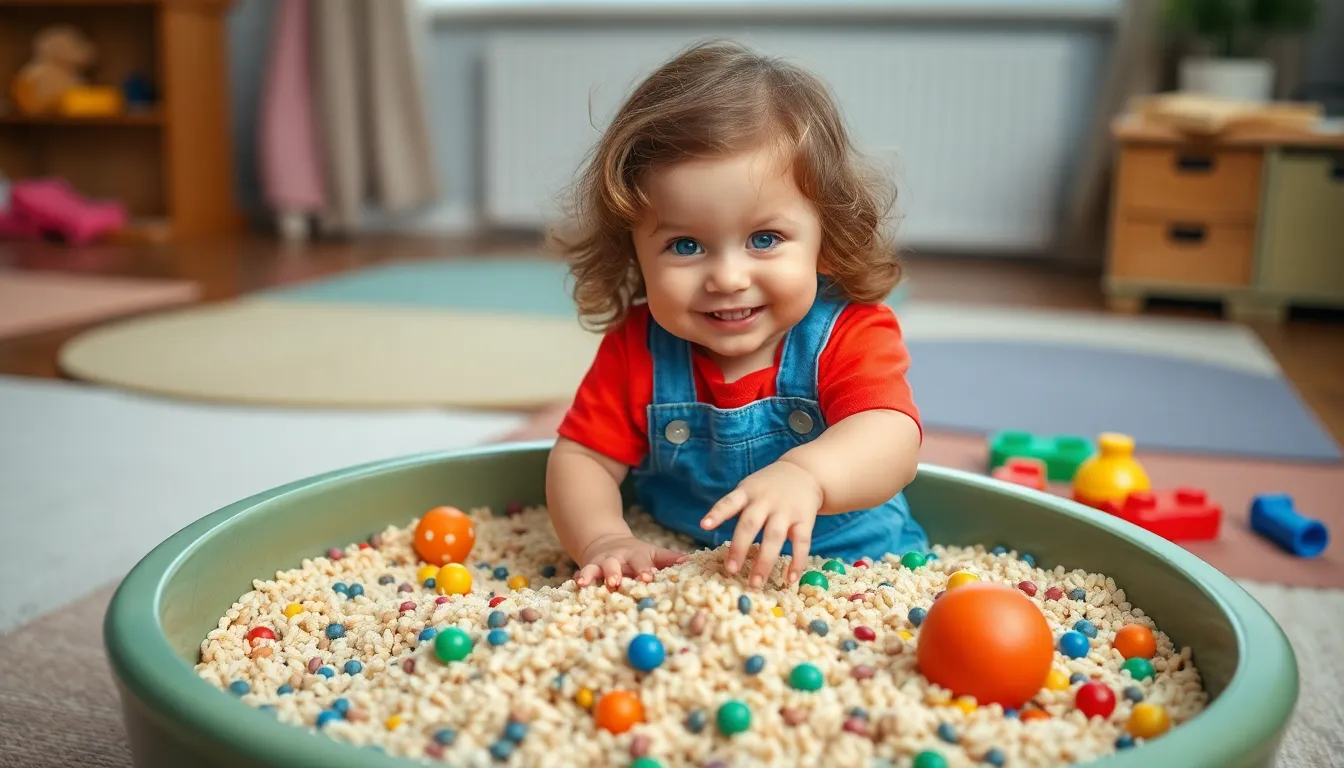Toddlers are natural explorers, constantly discovering the world around them. But sometimes, their curiosity needs a little nudge. Enter sensory activities—an exciting way to engage those tiny hands and curious minds. These activities not only keep little ones entertained but also help develop essential skills like motor coordination and problem-solving.
Table of Contents
ToggleOverview of Toddler Sensory Activities
Toddler sensory activities engage multiple senses, promoting exploration and learning. These activities stimulate touch, smell, sight, taste, and hearing, creating a holistic learning experience. Parents and caregivers find various simple activities suitable for home environments.
Common examples include sensory bins filled with rice, beans, or sand. Children benefit from digging, pouring, and sorting materials within these bins. Playdough encourages creativity, allowing toddlers to manipulate textures while enhancing fine motor skills.
Water play offers another engaging option. Using containers, toys, and various kitchen utensils, toddlers explore pouring and splashing while developing hand-eye coordination. Nature-based activities also play a significant role. Collecting leaves or rocks for sorting lessons connects children with the outdoor environment.
Art projects involving edible paints or textured materials expand creative boundaries. These projects encourage experimentation and exploration, further enhancing critical thinking skills. Messy play with materials like whipped cream or shaving foam delights toddlers, fostering sensory experiences while promoting tactile learning.
How to integrate these activities into daily routines varies. Setting aside dedicated playtime keeps toddlers engaged and promotes consistent learning. Incorporating sensory activities during everyday tasks, like cooking or gardening, also enhances learning experiences.
A focus on sensory activities supports developmental milestones. Motor coordination, problem-solving skills, and language development accelerate through active participation. Overall, toddler sensory activities serve as essential tools for fostering curiosity, creativity, and cognitive growth.
Benefits of Sensory Play

Sensory play offers numerous advantages for toddlers, enhancing both development and social interactions.
Developmental Advantages
Engaging in sensory play promotes crucial developmental skills. Children refine fine motor skills through activities like scooping and pouring. Exploration with various textures and materials fosters cognitive growth and problem-solving abilities. Multi-sensory experiences enable toddlers to make connections about their environment, enriching their understanding of the world. Additionally, activities encourage creativity and imaginative play, vital aspects of emotional development. Regular participation supports reaching developmental milestones, laying the foundation for future learning.
Emotional and Social Growth
Sensory activities contribute significantly to emotional and social development. Playtime encourages sharing, cooperation, and communication with peers, fostering social skills. While engaging in group activities, toddlers practice patience and negotiation. Exploration of different materials stimulates curiosity, leading to improved self-expression and emotional regulation. Furthermore, these activities provide opportunities for children to exhibit initiative and confidence as they explore new experiences. Building connections with others through shared play enhances emotional bonds between children and their caregivers.
Types of Toddler Sensory Activities
Various sensory activities enrich toddlers’ learning through play. These activities fall into two primary categories: indoor and outdoor.
Indoor Sensory Activities
Indoor sensory activities stimulate toddlers’ senses while promoting creativity. Sensory bins filled with materials like rice or beans allow children to sift and explore textures. Playdough encourages imaginative sculpting and strengthens fine motor skills. Water play in small containers incorporates pouring and splashing, enhancing hand-eye coordination. Painting with edible materials can spark artistic expression while keeping safety in mind. Exploring items with different textures fosters tactile learning, making every indoor space an opportunity for discovery.
Outdoor Sensory Activities
Outdoor sensory activities connect toddlers with nature and expand their experiences. Nature walks provide opportunities to observe different sounds and sights, encouraging curiosity about the environment. Sand and water play encourages tactile exploration, allowing kids to dig and build structures. Gardening activities engage children’s senses as they plant seeds and feel soil. Outdoor art projects can involve natural materials, promoting creativity and environmental awareness. Exploring sensory paths made of varied textures emphasizes movement and sensory feedback, making outdoor playtime both fun and educational.
Tips for Incorporating Sensory Activities at Home
Incorporating sensory activities at home enriches a toddler’s development and engages their curiosity effectively. Start by designating a specific area for sensory play to minimize clutter and manage mess. Select materials like rice, beans, or sand for sensory bins; these are inviting and encourage tactile exploration.
Consider varying the textures and materials in sensory bins. Mixing different items, such as pasta, pebbles, or fabric scraps, stimulates various senses, making playtime more enriching. Use containers for pouring and sorting activities; this helps toddlers develop fine motor skills while having fun.
Incorporate everyday items into sensory experiences. Water play using kitchen bowls, measuring cups, and sponges provides hours of enjoyment while enhancing hand-eye coordination. Art projects that employ edible paints promote creativity and sensory exploration simultaneously.
Utilize the outdoors for unique sensory opportunities. Nature walks introduce toddlers to the sounds and sights of their environment. Collect leaves, rocks, or flowers for categorizing and sorting later at home, reinforcing learning through interaction with nature.
Engage in messy play to broaden sensory experiences. Simple activities, like finger painting or playing with whipped cream, allow for unrestricted exploration. Messiness often enhances tactile experiences and invites creativity in unexpected ways.
Schedule sensory activities regularly, integrating them into daily routines to enhance engagement. Familiarity with activities promotes confidence and self-expression. Emphasize the importance of interaction; engaging with peers during sensory play encourages sharing, communication, and cooperation skills.
Highlight the benefits of vary types of sensory activities, knowing they support crucial developmental milestones. Prioritizing sensory play fosters emotional regulation, curiosity, and creativity, promoting well-rounded growth in toddlers.
Safety Considerations for Sensory Play
Ensuring safety during sensory activities is vital for toddlers. Parents must monitor all materials used to prevent choking hazards. Assessing items for small parts keeps little ones safe.
Using non-toxic substances is essential when creating sensory bins. Natural materials like rice, beans, or sand are safe options. Avoid items that contain harmful chemicals to promote a secure play environment.
Incorporating supervision during messy play activities protects toddlers from unexpected accidents. Messy materials like whipped cream or paint should be used within designated areas. Setting boundaries helps maintain a safe play zone, minimizing slip hazards.
Establishing clear rules for sensory play fosters understanding of safe practices. Explaining appropriate behaviors helps toddlers differentiate between safe exploration and risky actions. Encouraging them to express when something feels uncomfortable contributes to their comfort during play.
Always having a first aid kit nearby prepares caregivers for minor accidents. Keeping band-aids, antiseptic wipes, and gauze readily accessible ensures quick response to any injuries. Regularly checking the play area for hazards reinforces a safe environment.
Cleaning up promptly after sensory play activities prevents slips and falls. Removing spilled materials, like beans or water, keeps the play area secure. Demonstrating proper cleanup also teaches toddlers responsibility regarding their surroundings.
Using age-appropriate activities enhances safety. Tailoring sensory experiences to the developmental stage of toddlers ensures they engage safely. Encouraging exploration while prioritizing safety builds confidence in their abilities.
Incorporating sensory activities into a toddler’s routine is a powerful way to nurture their natural curiosity and development. These experiences not only entertain but also enhance essential skills like motor coordination and problem-solving. By engaging multiple senses toddlers gain a richer understanding of their environment.
Parents and caregivers can easily create stimulating sensory experiences at home with simple materials. Whether through indoor activities like playdough or outdoor explorations in nature these activities foster creativity and social interaction. Prioritizing sensory play contributes to emotional regulation and encourages toddlers to express themselves confidently.
Ultimately embracing sensory activities supports well-rounded growth in toddlers. With careful planning and safety considerations parents can create an enriching environment that promotes exploration and learning.



